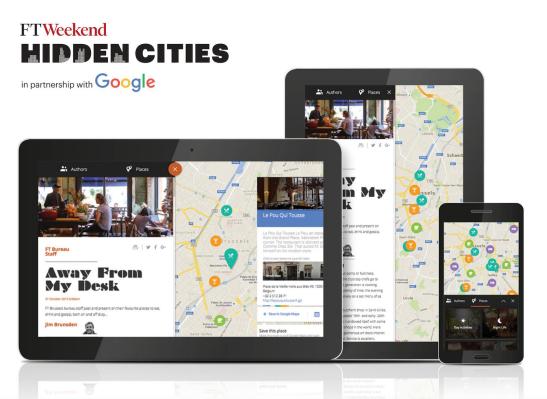Here’s a fun example of how news publishers can take advantage of technology — the Financial Times just launched a collaboration with Google called Hidden Cities.
Brussels is the first city to get the spotlight, with the FT highlighting the city’s “best-kept secrets,” with recommendations for bars, restaurants and other cultural attractions from its correspondents. Noteworthy locals participated too, including Paul Dujardin (director of fine arts center Bozar), Alain Coumont (owner of bakery-restaurant chain Le Pain Quotidien) and Martine Reicherts (director-general of education and culture for the European Commission).
These recommendations are presented in an interactive Google Maps format. While we’re not quite talking about Snow Fall levels of innovation, Google’s Ramya Raghavan (who leads brand marketing for Europe, the Middle East and Africa) said she’s “particularly excited” about this project because it represents the intersection of quality content and technology, with the Google Maps-centric presentation making the editorial recommendations more useful.
“I read the FT Weekend all the time,” Raghavan said. “Now I’ll be able to read about a restaurant and get turn-by-turn directions to go there, or be able to add it to my Google Calendar.”
She also said the Hidden Cities project highlights some new capabilities in Google Maps — it allows users to save a location from the Hidden Cities website directly to their Google Maps mobile app.
“The project is built squarely upon the Google Maps API, so it’s very much the type of technology every developer or publication can access,” Raghavan added.
Natalie Whittle, associate editor for the FT Weekend Magazine, described the collaboration with Google as a “motorcycle-and-sidecar arrangement.” Google provided technical support, but the FT team had “absolute editorial independence,” she said.
“Our mantra at the FT at the moment is ‘digital first’,” Whittle said. However, that doesn’t mean excluding print completely. The guide will in fact be included in a supplement in the October 31 issue of the magazine — she said that reproducing the maps in print was both a “complex” task and “a good exercise.”
Why start with Brussels? Well, it helps that the FT has “a fairly sizable bureau there,” but Whittle also suggested that the city’s proximity to Paris may have caused it to be “overlooked on the tourist map, occasionally.”
“We really hope that this is something that will help people think about Brussels differently,” she said.
Next up is a Hidden Cities guide to London, due on November 28.
